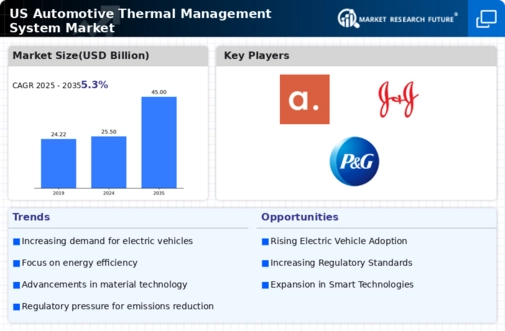Rising Demand for Fuel Efficiency
The automotive thermal-management-system market is experiencing a notable surge in demand for fuel efficiency. As consumers increasingly prioritize fuel economy, manufacturers are compelled to enhance thermal management systems to optimize engine performance and reduce energy consumption. This trend is particularly pronounced in light-duty vehicles, where the market is projected to grow at a CAGR of approximately 6.5% through 2028. Enhanced thermal management not only improves fuel efficiency but also contributes to lower emissions, aligning with consumer preferences for environmentally friendly vehicles. Consequently, the automotive thermal-management-system market is likely to witness significant investments aimed at developing advanced technologies that facilitate better heat dissipation and energy recovery.
Growth of Electric and Hybrid Vehicles
the automotive thermal-management-system market is influenced by the rapid growth of electric and hybrid vehicles. As these vehicles become more prevalent, the need for efficient thermal management systems to regulate battery temperatures and optimize performance is paramount. The market for electric vehicles in the US is projected to reach 7 million units by 2025, which underscores the increasing reliance on effective thermal management solutions. This growth necessitates the development of specialized thermal management systems that can handle the unique challenges posed by electric drivetrains. Consequently, the automotive thermal-management-system market is poised for expansion as manufacturers adapt to the evolving landscape of vehicle electrification.
Technological Advancements in Materials
Innovations in materials science are driving the automotive thermal-management-system market forward. The introduction of lightweight materials, such as advanced composites and high-performance polymers, is enabling manufacturers to create more efficient thermal management solutions. These materials can withstand higher temperatures while providing better insulation, which is crucial for electric and hybrid vehicles. The market for these advanced materials is expected to reach $1.5 billion by 2026, reflecting a growing recognition of their importance in enhancing vehicle performance. As manufacturers continue to explore new material options, the automotive thermal-management-system market is likely to benefit from improved product offerings that meet the demands of modern vehicles.
Regulatory Pressures for Emission Reductions
Regulatory pressures aimed at reducing vehicle emissions are significantly shaping the automotive thermal-management-system market. Stricter emissions standards imposed by government agencies are compelling manufacturers to invest in advanced thermal management technologies that enhance engine efficiency and minimize emissions. The US Environmental Protection Agency (EPA) has set ambitious targets for reducing greenhouse gas emissions from vehicles, which has led to a growing emphasis on thermal management solutions that can help meet these regulations. As a result, the automotive thermal-management-system market is likely to see increased investment in research and development, as manufacturers seek to comply with evolving regulatory frameworks while maintaining competitive performance.
Increased Consumer Awareness of Vehicle Performance
Consumer awareness regarding vehicle performance is a driving force in the automotive thermal-management-system market. As buyers become more informed about the impact of thermal management on overall vehicle efficiency and longevity, they are more likely to seek vehicles equipped with advanced thermal management systems. This trend is particularly evident in the SUV and truck segments, where performance and durability are key selling points. The automotive thermal-management-system market is expected to benefit from this heightened consumer interest, as manufacturers strive to meet the demand for vehicles that offer superior thermal management capabilities. This shift in consumer behavior may lead to increased competition among manufacturers to innovate and differentiate their thermal management solutions.














Leave a Comment